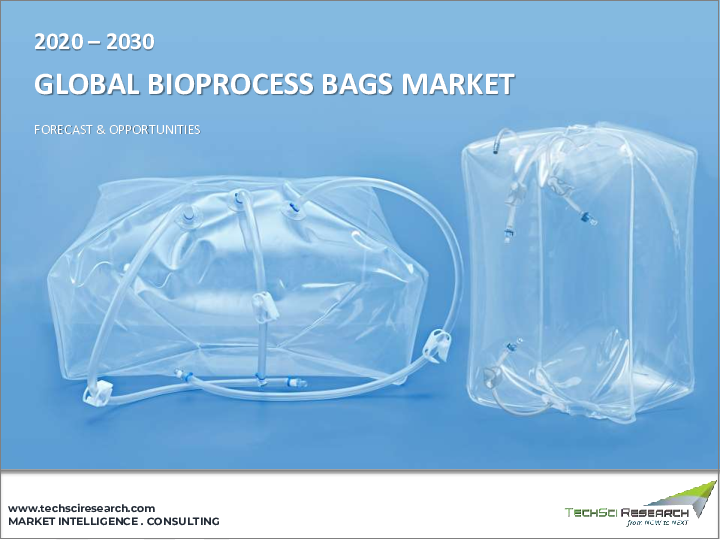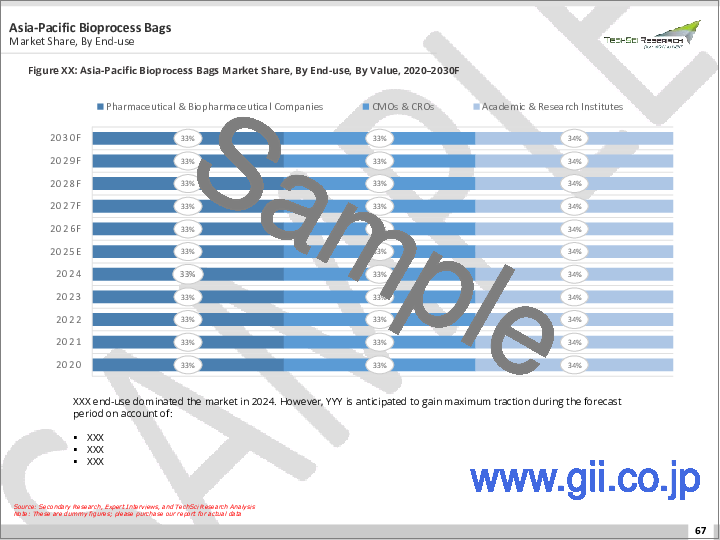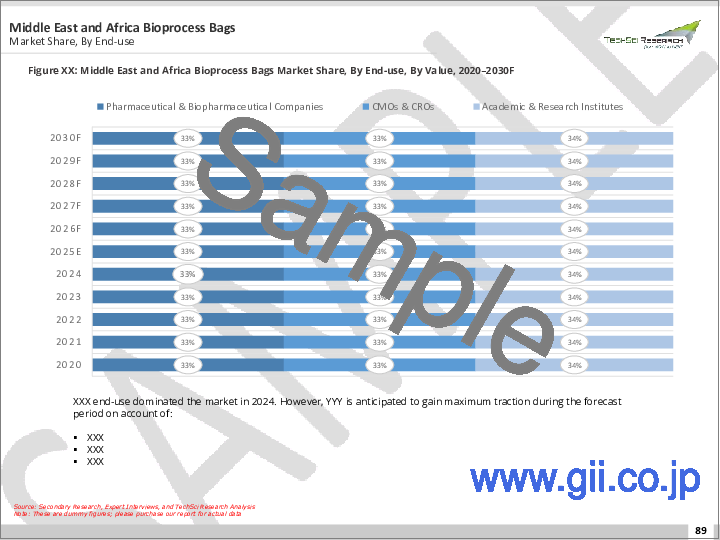|
|
市場調査レポート
商品コード
1691802
バイオプロセスバッグ市場- 世界の産業規模、シェア、動向、機会、予測、タイプ別、ワークフロー別、エンドユーザー別、地域別セグメント、競合、2020年~2030年Bioprocess Bags Market - Global Industry Size, Share, Trends, Opportunity, and Forecast, Segmented By Type, By Workflow, by End User, By Region and Competition, 2020-2030F |
||||||
カスタマイズ可能
|
|||||||
| バイオプロセスバッグ市場- 世界の産業規模、シェア、動向、機会、予測、タイプ別、ワークフロー別、エンドユーザー別、地域別セグメント、競合、2020年~2030年 |
|
出版日: 2025年03月24日
発行: TechSci Research
ページ情報: 英文 180 Pages
納期: 2~3営業日
|
全表示
- 概要
- 目次
バイオプロセスバッグの世界市場は2024年に32億1,000万米ドルと評価され、予測期間中のCAGRは13.52%で2030年には68億7,000万米ドルに達すると予測されています。
シングルユースバイオプロセスバッグや使い捨てバイオプロセスバッグとしても知られるバイオプロセスバッグは、バイオ医薬品やバイオプロセス産業で使用され、特に細胞培養、発酵、その他の関連アプリケーションの分野で、生物製剤や医薬品の生産と処理を容易にする特殊な容器です。これらのバッグは、バイオ医薬品業界の厳しい品質および規制要件を満たすように設計されています。バイオプロセスバッグは、主にバイオ医薬品製造やバイオ加工に関わる液体や材料の封入、保管、輸送に使用されます。バイオプロセスバッグは一般的に、強度、柔軟性、バイオプロセス液や化学薬品との適合性から選ばれた特殊な材料で作られています。これらの材料は、製品の安全性と完全性を確保するために、厳しい品質基準と規制基準を満たす必要があります。環境問題への関心の高まりを受けて、バイオプロセスバッグの中には、環境への影響を軽減するために、生分解性やリサイクル可能なオプションなど、環境に優しい素材で設計されているものもあります。
| 市場概要 | |
|---|---|
| 予測期間 | 2026-2030 |
| 市場規模:2024年 | 32億1,000万米ドル |
| 市場規模:2030年 | 68億7,000万米ドル |
| CAGR:2025年~2030年 | 13.52% |
| 急成長セグメント | 上流プロセス |
| 最大市場 | 北米 |
モノクローナル抗体、遺伝子治療、ワクチンなどのバイオ医薬品の需要拡大が大きな原動力となっています。バイオプロセスバッグは、これらの高度な治療法の生産に不可欠です。バイオプロセスバッグを含むシングルユース・バイオプロセシングシステムの採用は、その費用対効果、柔軟性、汚染リスクの低減により増加しています。バイオプロセスバッグは、小規模な研究開発から大規模な生産までスケーラビリティを提供し、様々な市場の需要に応えるために必要な柔軟性を提供します。バイオプロセスバッグを含むシングルユースシステムは、従来のステンレス製機器に伴う、時間とコストのかかる洗浄・滅菌工程の必要性を低減します。バイオプロセスバッグのデザインや素材の革新により、性能、無菌性、様々なバイオプロセスシステムとの適合性が向上しています。バイオプロセスバッグのカスタマイズオプションを提供するメーカーは、企業が特定のニーズに合わせてバッグをカスタマイズすることを可能にし、需要をさらに促進しています。
主要市場促進要因
技術の進歩
主な市場課題
原材料コスト
主要市場動向
バイオプロセスバッグのカスタマイズ
目次
第1章 概要
第2章 調査手法
第3章 エグゼクティブサマリー
第4章 顧客の声
第5章 世界のバイオプロセスバッグ市場展望
- 市場規模・予測
- 金額別
- 市場シェア・予測
- タイプ別(2Dバイオプロセスバッグ、3Dバイオプロセスバッグ、その他のバッグとアクセサリ)
- ワークフロー別(上流工程、下流工程、プロセス開発)
- エンドユーザー別(製薬・バイオ医薬品企業、CMO・CRO、学術・調査機関)
- 地域別
- 企業別(2024)
- 市場マップ
第6章 アジア太平洋地域のバイオプロセスバッグ市場展望
- 市場規模・予測
- 市場シェア・予測
- アジア太平洋地域:国別分析
- 中国
- インド
- オーストラリア
- 日本
- 韓国
第7章 欧州のバイオプロセスバッグ市場展望
- 市場規模・予測
- 市場シェア・予測
- 欧州:国別分析
- フランス
- ドイツ
- スペイン
- イタリア
- 英国
第8章 北米のバイオプロセスバッグ市場展望
- 市場規模・予測
- 市場シェア・予測
- 北米:国別分析
- 米国
- メキシコ
- カナダ
第9章 南米のバイオプロセスバッグ市場展望
- 市場規模・予測
- 市場シェア・予測
- 南米:国別分析
- ブラジル
- アルゼンチン
- コロンビア
第10章 中東・アフリカのバイオプロセスバッグ市場展望
- 市場規模・予測
- 市場シェア・予測
- 中東・アフリカ:国別分析
- 南アフリカ
- サウジアラビア
- アラブ首長国連邦
第11章 市場力学
- 促進要因
- 課題
第12章 市場動向と発展
- 最近の動向
- 製品上市
- 合併と買収
第13章 世界のバイオプロセスバッグ市場:SWOT分析
第14章 ポーターのファイブフォース分析
- 業界内の競合
- 新規参入の可能性
- サプライヤーの力
- 顧客の力
- 代替品の脅威
第15章 PESTEL分析
第16章 競合情勢
- Meissner Filtration Products, Inc.
- Thermo Fisher Scientific Inc.
- Sartorius AG
- Danaher Corporation
- Merck KGaA
- Saint-Gobain
- Corning Incorporated
- Entegris
- PROAnalytics, LLC
- CellBios Healthcare and Lifesciences Pvt Ltd.
第17章 戦略的提言
第18章 調査会社について・免責事項
Global Bioprocess Bags Market was valued at USD 3.21 billion in 2024 and is expected to reach USD 6.87 billion by 2030 with a CAGR of 13.52% during the forecast period. Bioprocess bags, also known as single-use bioprocess bags or disposable bioprocess bags, are specialized containers used in biopharmaceutical and bioprocessing industries to facilitate the production and processing of biologics and pharmaceuticals, particularly in the fields of cell culture, fermentation, and other related applications. These bags are designed to meet the stringent quality and regulatory requirements of the biopharmaceutical industry. Bioprocess bags are primarily used to contain, store, and transport liquids and materials involved in biopharmaceutical manufacturing and bioprocessing. Bioprocess bags are typically made from specialized materials that are chosen for their strength, flexibility, and compatibility with bioprocessing fluids and chemicals. These materials must meet stringent quality and regulatory standards to ensure product safety and integrity. In response to growing environmental concerns, some bioprocess bags are designed with eco-friendly materials, such as biodegradable or recyclable options, to reduce their environmental impact.
| Market Overview | |
|---|---|
| Forecast Period | 2026-2030 |
| Market Size 2024 | USD 3.21 Billion |
| Market Size 2030 | USD 6.87 Billion |
| CAGR 2025-2030 | 13.52% |
| Fastest Growing Segment | Upstream Process |
| Largest Market | North America |
The growing demand for biopharmaceuticals, including monoclonal antibodies, gene therapies, and vaccines, is a major driver. Bioprocess bags are essential to produce these advanced therapies. The adoption of single use bioprocessing systems, including bioprocess bags, is increasing due to their cost-effectiveness, flexibility, and reduced risk of contamination. Bioprocess bags offer scalability from small-scale research and development to large-scale production, providing the flexibility required to meet varying market demands. Single-use systems, including bioprocess bags, reduce the need for time-consuming and costly cleaning and sterilization processes associated with traditional stainless-steel equipment. Innovations in bioprocess bag design and materials have improved their performance, sterility, and compatibility with various bioprocessing systems. Manufacturers offering customization options for bioprocess bags enable companies to tailor the bags to their specific needs further driving demand.
Key Market Drivers
Technological Advancements
Technological advancements in bioprocess bags have contributed to the evolution and improvement of these critical components in biopharmaceutical manufacturing and bioprocessing. These innovations aim to enhance performance, sterility, ease of use, and the overall efficiency of bioprocess operations. Manufacturers have developed novel materials for bioprocess bags that offer improved strength, flexibility, and resistance to various chemicals. These materials are designed to ensure the bags' integrity throughout the production process. Enhanced aseptic manufacturing processes and improved closures and connectors help maintain the sterility of bioprocess bags, reducing the risk of contamination during production. Some bioprocess bags now feature baffle systems, which are internal structures that promote better mixing and oxygen transfer during cell culture and fermentation processes. This improves the homogeneity of the culture and enhances yield. Technological advancements have allowed for better scalability of bioprocess bags, facilitating the transition from small-scale research and development to large-scale manufacturing without significant process changes. Bioprocess bags with integrated sensors can provide real-time data on critical process parameters like temperature, pH, and dissolved oxygen. This data helps operators monitor and control the process more effectively. Smart bioprocess bags can communicate with control systems and software, allowing for automated process monitoring and control. This helps optimize process parameters in real time. Advanced bag designs incorporate improved mixing technologies, such as rocking or wave-induced motion, to enhance cell culture and fermentation performance.
Key Market Challenges
Raw Material Costs
Bioprocess bags require materials that meet rigorous quality and sterility requirements. These materials are often more expensive than standard plastics, contributing to the overall cost of production. Bioprocess bags must comply with strict regulatory standards, particularly in the biopharmaceutical industry. Ensuring materials meet these standards can require additional quality control measures and may involve higher costs. Bioprocess bags are often customized to meet the specific requirements of individual companies and processes. Customization can lead to variations in material requirements, making it challenging to manage costs efficiently. As environmental concerns grow, some companies may seek eco-friendly materials for bioprocess bags. While these materials may have a lower environmental impact, they can sometimes be more expensive than traditional materials. Raw material costs can be subject to market fluctuations, which can impact the overall production cost of bioprocess bags. Disruptions in the supply chain, such as those experienced during global events like the COVID-19 pandemic, can lead to shortages and price increases for certain materials. Manufacturers may invest in research and development to improve bioprocess bag materials, which can lead to increased costs associated with developing and producing these advanced materials. Ensuring consistent quality and performance of materials in bioprocess bags may require stringent quality control processes, adding to the overall production cost.
Key Market Trends
Bioprocess Bag Customization
Biopharmaceutical companies have unique processes and equipment setups. Customized bioprocess bags can be designed to seamlessly integrate with existing systems, optimizing the overall production process. Bioprocess bag manufacturers offer customization options to ensure compatibility with a wide range of bioprocessing equipment, such as bioreactors, mixers, and connectors. This compatibility is essential for efficient and successful operations. Customization allows companies to specify the bag size, configuration, and ports that best suit their processes. This level of tailoring ensures that the bags are an exact fit for the application. Some biopharmaceutical processes are unique and require specialized equipment and containers. Customized bioprocess bags can accommodate these distinctive requirements.
Companies can choose the materials that best align with their product and process needs, considering factors like material strength, flexibility, and sterility. Customized bags can incorporate quality control features specific to a company's processes, such as integrated sensors for real-time monitoring of critical parameters. Companies focused on sustainability may request custom bioprocess bags made from eco-friendly materials or with reduced plastic content. Customization can address specific regulatory requirements and standards relevant to a particular application, ensuring that the bags meet compliance standards. By tailoring bioprocess bags to their exact needs, companies can improve process efficiency and reduce waste. This can lead to cost savings and higher overall productivity. Customization allows companies to differentiate their products and processes in the market. It can be a competitive advantage and may attract customers who seek tailored solutions.
Key Market Players
- Meissner Filtration Products, Inc.
- Thermo Fisher Scientific Inc.
- Sartorius AG
- Danaher Corporation
- Merck KGaA
- Saint-Gobain
- Corning Incorporated
- Entegris
- PROAnalytics, LLC
- CellBios Healthcare and Lifesciences Pvt Ltd.
Report Scope:
In this report, the Global Bioprocess Bags Market has been segmented into the following categories, in addition to the industry trends which have also been detailed below:
Bioprocess Bags Market, By Type:
- 2D Bioprocess Bags
- 3D Bioprocess Bags
- Other Bags & Accessories
Bioprocess Bags Market, By Workflow:
- Upstream Process
- Downstream Process
- Process Development
Bioprocess Bags Market, By End-User:
- Pharmaceutical & Biopharmaceutical Companies
- CMOs & CROs
- Academic & Research Institutes
Bioprocess Bags Market, By region:
- North America
- United States
- Canada
- Mexico
- Asia-Pacific
- China
- India
- South Korea
- Australia
- Japan
- Europe
- Germany
- France
- United Kingdom
- Spain
- Italy
- South America
- Brazil
- Argentina
- Colombia
- Middle East & Africa
- South Africa
- Saudi Arabia
- UAE
Competitive Landscape
Company Profiles: Detailed analysis of the major companies presents in the Global Bioprocess Bags Market.
Available Customizations:
Global Bioprocess Bags Market report with the given market data, TechSci Research offers customizations according to a company's specific needs. The following customization options are available for the report:
Company Information
- Detailed analysis and profiling of additional market players (up to five).
Table of Contents
1. Product Overview
- 1.1. Market Definition
- 1.2. Scope of the Market
- 1.2.1. Markets Covered
- 1.2.2. Years Considered for Study
- 1.2.3. Key Market Segmentations
2. Research Methodology
- 2.1. Objective of the Study
- 2.2. Baseline Methodology
- 2.3. Key Industry Partners
- 2.4. Major Association and Secondary Sources
- 2.5. Forecasting Methodology
- 2.6. Data Triangulation & Validation
- 2.7. Assumptions and Limitations
3. Executive Summary
- 3.1. Overview of the Market
- 3.2. Overview of Key Market Segmentations
- 3.3. Overview of Key Market Players
- 3.4. Overview of Key Regions/Countries
- 3.5. Overview of Market Drivers, Challenges, Trends
4. Voice of Customer
5. Global Bioprocess Bags Market Outlook
- 5.1. Market Size & Forecast
- 5.1.1. By Value
- 5.2. Market Share & Forecast
- 5.2.1. By Type (2D Bioprocess Bags, 3D Bioprocess Bags, Other Bags & Accessories)
- 5.2.2. By Workflow (Upstream Process, Downstream Process, Process Development)
- 5.2.3. By End User (Pharmaceutical & Biopharmaceutical Companies, CMOs & CROs, Academic & Research Institutes)
- 5.2.4. By Region
- 5.2.5. By Company (2024)
- 5.3. Market Map
6. Asia Pacific Bioprocess Bags Market Outlook
- 6.1. Market Size & Forecast
- 6.1.1. By Value
- 6.2. Market Share & Forecast
- 6.2.1. By Type
- 6.2.2. By Workflow
- 6.2.3. By End User
- 6.2.4. By Country
- 6.3. Asia Pacific: Country Analysis
- 6.3.1. China Bioprocess Bags Market Outlook
- 6.3.1.1. Market Size & Forecast
- 6.3.1.1.1. By Value
- 6.3.1.2. Market Share & Forecast
- 6.3.1.2.1. By Type
- 6.3.1.2.2. By Workflow
- 6.3.1.2.3. By End User
- 6.3.1.1. Market Size & Forecast
- 6.3.2. India Bioprocess Bags Market Outlook
- 6.3.2.1. Market Size & Forecast
- 6.3.2.1.1. By Value
- 6.3.2.2. Market Share & Forecast
- 6.3.2.2.1. By Type
- 6.3.2.2.2. By Workflow
- 6.3.2.2.3. By End User
- 6.3.2.1. Market Size & Forecast
- 6.3.3. Australia Bioprocess Bags Market Outlook
- 6.3.3.1. Market Size & Forecast
- 6.3.3.1.1. By Value
- 6.3.3.2. Market Share & Forecast
- 6.3.3.2.1. By Type
- 6.3.3.2.2. By Workflow
- 6.3.3.2.3. By End User
- 6.3.3.1. Market Size & Forecast
- 6.3.4. Japan Bioprocess Bags Market Outlook
- 6.3.4.1. Market Size & Forecast
- 6.3.4.1.1. By Value
- 6.3.4.2. Market Share & Forecast
- 6.3.4.2.1. By Type
- 6.3.4.2.2. By Workflow
- 6.3.4.2.3. By End User
- 6.3.4.1. Market Size & Forecast
- 6.3.5. South Korea Bioprocess Bags Market Outlook
- 6.3.5.1. Market Size & Forecast
- 6.3.5.1.1. By Value
- 6.3.5.2. Market Share & Forecast
- 6.3.5.2.1. By Type
- 6.3.5.2.2. By Workflow
- 6.3.5.2.3. By End User
- 6.3.5.1. Market Size & Forecast
- 6.3.1. China Bioprocess Bags Market Outlook
7. Europe Bioprocess Bags Market Outlook
- 7.1. Market Size & Forecast
- 7.1.1. By Value
- 7.2. Market Share & Forecast
- 7.2.1. By Type
- 7.2.2. By Workflow
- 7.2.3. By End User
- 7.2.4. By Country
- 7.3. Europe: Country Analysis
- 7.3.1. France Bioprocess Bags Market Outlook
- 7.3.1.1. Market Size & Forecast
- 7.3.1.1.1. By Value
- 7.3.1.2. Market Share & Forecast
- 7.3.1.2.1. By Type
- 7.3.1.2.2. By Workflow
- 7.3.1.2.3. By End User
- 7.3.1.1. Market Size & Forecast
- 7.3.2. Germany Bioprocess Bags Market Outlook
- 7.3.2.1. Market Size & Forecast
- 7.3.2.1.1. By Value
- 7.3.2.2. Market Share & Forecast
- 7.3.2.2.1. By Type
- 7.3.2.2.2. By Workflow
- 7.3.2.2.3. By End User
- 7.3.2.1. Market Size & Forecast
- 7.3.3. Spain Bioprocess Bags Market Outlook
- 7.3.3.1. Market Size & Forecast
- 7.3.3.1.1. By Value
- 7.3.3.2. Market Share & Forecast
- 7.3.3.2.1. By Type
- 7.3.3.2.2. By Workflow
- 7.3.3.2.3. By End User
- 7.3.3.1. Market Size & Forecast
- 7.3.4. Italy Bioprocess Bags Market Outlook
- 7.3.4.1. Market Size & Forecast
- 7.3.4.1.1. By Value
- 7.3.4.2. Market Share & Forecast
- 7.3.4.2.1. By Type
- 7.3.4.2.2. By Workflow
- 7.3.4.2.3. By End User
- 7.3.4.1. Market Size & Forecast
- 7.3.5. United Kingdom Bioprocess Bags Market Outlook
- 7.3.5.1. Market Size & Forecast
- 7.3.5.1.1. By Value
- 7.3.5.2. Market Share & Forecast
- 7.3.5.2.1. By Type
- 7.3.5.2.2. By Workflow
- 7.3.5.2.3. By End User
- 7.3.5.1. Market Size & Forecast
- 7.3.1. France Bioprocess Bags Market Outlook
8. North America Bioprocess Bags Market Outlook
- 8.1. Market Size & Forecast
- 8.1.1. By Value
- 8.2. Market Share & Forecast
- 8.2.1. By Type
- 8.2.2. By Workflow
- 8.2.3. By End User
- 8.2.4. By Country
- 8.3. North America: Country Analysis
- 8.3.1. United States Bioprocess Bags Market Outlook
- 8.3.1.1. Market Size & Forecast
- 8.3.1.1.1. By Value
- 8.3.1.2. Market Share & Forecast
- 8.3.1.2.1. By Type
- 8.3.1.2.2. By Workflow
- 8.3.1.2.3. By End User
- 8.3.1.1. Market Size & Forecast
- 8.3.2. Mexico Bioprocess Bags Market Outlook
- 8.3.2.1. Market Size & Forecast
- 8.3.2.1.1. By Value
- 8.3.2.2. Market Share & Forecast
- 8.3.2.2.1. By Type
- 8.3.2.2.2. By Workflow
- 8.3.2.2.3. By End User
- 8.3.2.1. Market Size & Forecast
- 8.3.3. Canada Bioprocess Bags Market Outlook
- 8.3.3.1. Market Size & Forecast
- 8.3.3.1.1. By Value
- 8.3.3.2. Market Share & Forecast
- 8.3.3.2.1. By Type
- 8.3.3.2.2. By Workflow
- 8.3.3.2.3. By End User
- 8.3.3.1. Market Size & Forecast
- 8.3.1. United States Bioprocess Bags Market Outlook
9. South America Bioprocess Bags Market Outlook
- 9.1. Market Size & Forecast
- 9.1.1. By Value
- 9.2. Market Share & Forecast
- 9.2.1. By Type
- 9.2.2. By Workflow
- 9.2.3. By End User
- 9.2.4. By Country
- 9.3. South America: Country Analysis
- 9.3.1. Brazil Bioprocess Bags Market Outlook
- 9.3.1.1. Market Size & Forecast
- 9.3.1.1.1. By Value
- 9.3.1.2. Market Share & Forecast
- 9.3.1.2.1. By Type
- 9.3.1.2.2. By Workflow
- 9.3.1.2.3. By End User
- 9.3.1.1. Market Size & Forecast
- 9.3.2. Argentina Bioprocess Bags Market Outlook
- 9.3.2.1. Market Size & Forecast
- 9.3.2.1.1. By Value
- 9.3.2.2. Market Share & Forecast
- 9.3.2.2.1. By Type
- 9.3.2.2.2. By Workflow
- 9.3.2.2.3. By End User
- 9.3.2.1. Market Size & Forecast
- 9.3.3. Colombia Bioprocess Bags Market Outlook
- 9.3.3.1. Market Size & Forecast
- 9.3.3.1.1. By Value
- 9.3.3.2. Market Share & Forecast
- 9.3.3.2.1. By Type
- 9.3.3.2.2. By Workflow
- 9.3.3.2.3. By End User
- 9.3.3.1. Market Size & Forecast
- 9.3.1. Brazil Bioprocess Bags Market Outlook
10. Middle East and Africa Bioprocess Bags Market Outlook
- 10.1. Market Size & Forecast
- 10.1.1. By Value
- 10.2. Market Share & Forecast
- 10.2.1. By Type
- 10.2.2. By Workflow
- 10.2.3. By End User
- 10.2.4. By Country
- 10.3. MEA: Country Analysis
- 10.3.1. South Africa Bioprocess Bags Market Outlook
- 10.3.1.1. Market Size & Forecast
- 10.3.1.1.1. By Value
- 10.3.1.2. Market Share & Forecast
- 10.3.1.2.1. By Type
- 10.3.1.2.2. By Workflow
- 10.3.1.2.3. By End User
- 10.3.1.1. Market Size & Forecast
- 10.3.2. Saudi Arabia Bioprocess Bags Market Outlook
- 10.3.2.1. Market Size & Forecast
- 10.3.2.1.1. By Value
- 10.3.2.2. Market Share & Forecast
- 10.3.2.2.1. By Type
- 10.3.2.2.2. By Workflow
- 10.3.2.2.3. By End User
- 10.3.2.1. Market Size & Forecast
- 10.3.3. UAE Bioprocess Bags Market Outlook
- 10.3.3.1. Market Size & Forecast
- 10.3.3.1.1. By Value
- 10.3.3.2. Market Share & Forecast
- 10.3.3.2.1. By Type
- 10.3.3.2.2. By Workflow
- 10.3.3.2.3. By End User
- 10.3.3.1. Market Size & Forecast
- 10.3.1. South Africa Bioprocess Bags Market Outlook
11. Market Dynamics
- 11.1. Drivers
- 11.2. Challenges
12. Market Trends & Developments
- 12.1. Recent Developments
- 12.2. Product Launches
- 12.3. Mergers & Acquisitions
13. Global Bioprocess Bags Market: SWOT Analysis
14. Porter's Five Forces Analysis
- 14.1. Competition in the Industry
- 14.2. Potential of New Entrants
- 14.3. Power of Suppliers
- 14.4. Power of Customers
- 14.5. Threat of Substitute Product
15. PESTLE Analysis
16. Competitive Landscape
- 16.1. Meissner Filtration Products, Inc.
- 16.1.1. Business Overview
- 16.1.2. Company Snapshot
- 16.1.3. Products & Services
- 16.1.4. Financials (In case of listed companies)
- 16.1.5. Recent Developments
- 16.1.6. Key Personnel Details
- 16.1.7. SWOT Analysis
- 16.2. Thermo Fisher Scientific Inc.
- 16.3. Sartorius AG
- 16.4. Danaher Corporation
- 16.5. Merck KGaA
- 16.6. Saint-Gobain
- 16.7. Corning Incorporated
- 16.8. Entegris
- 16.9. PROAnalytics, LLC
- 16.10.CellBios Healthcare and Lifesciences Pvt Ltd.





